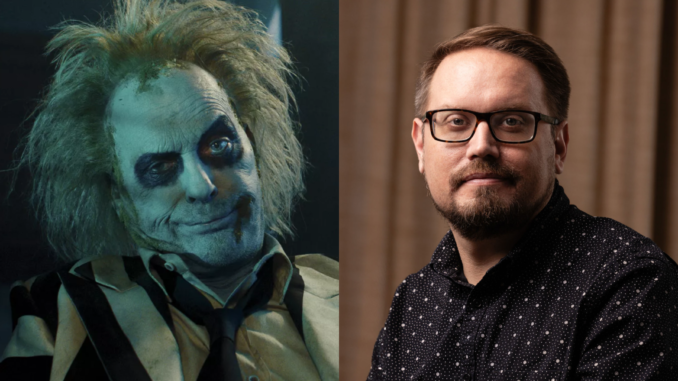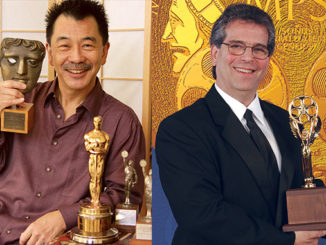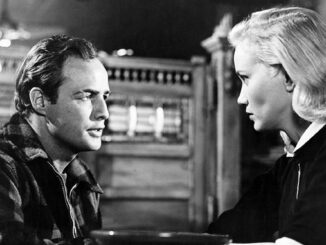
By Rob Feld
Jay Prychidny’s career as an editor has often blended horror and humor, from the “Scream” franchise to Tim Burton’s “Wednesday” series.
But his latest collaboration with Burton, “Beetlejuice Beetlejuice,” really brought it all home. “The original [‘Beetlejuice’ in 1988] was my favorite movie as a kid,” he said. “I was obsessed with it for two years.”
In the sequel, Lydia Deetz (Winona Ryder), now the host of a supernatural talk show called Ghost House, is estranged from her daughter Astrid (Jenna Ortega) following the death of her husband, Richard. While mourning her father Charles’ passing, Lydia is pressured into a Halloween marriage proposal from her producer Rory (Justin Theroux). In the afterlife, Beetlejuice (Michael Keaton) offers to help Lydia rescue Astrid from danger in exchange for marriage.
The trick was to respect the original film and the supernatural world by avoiding too much exposition and finding the delicate balance between horror and humor. Prychidny called on all his past experience to bring it off, but still managed to learn some new lessons in the process.
CineMontage: You’re deeply in Tim Burton-world. Had you heard talk about making a “Beetlejuice” sequel for a while?
Jay Prychidny: The way Tim works, he doesn’t talk about projects too much in advance. At the time, I was on “Scream VI” and had heard the writers were doing a pass on the “Beetlejuice” sequel, but lots of writers had been doing passes on it for decades. So, when I heard something was happening, I kept in touch, but Tim never confirmed it was moving forward. He would say, “People say they want it, but until it’s greenlit, you never know.” When it finally did get greenlit, I was thrilled they asked me to be part of it.
CineMontage: What were the discussions about the approach with Tim in the beginning? Did you reference the original or bring a new aesthetic for today?
Prychidny: Tim doesn’t discuss things ahead of time. His process is very organic and evolutionary, so it’s not about having big discussions beforehand. It’s more about getting on set and seeing what happens—what the actors, art department, and cinematographer bring. Editorial is a big part of his process. We talk every day, often multiple times, during breaks. He’ll come by the edit room, we’ll look at dailies, and go over the scenes I’ve cut from the previous day. It’s very responsive—he likes to see something, react to it, and then move forward.
CineMontage: So what started to emerge for you as these discussions evolved in real-time? Did you discover an approach you could articulate?
Prychidny: One thing I asked was about Beetlejuice’s “Looney Tunes” vibe from the original. I wanted to know if that would be part of the editorial language for the sequel, and Tim said yes, absolutely. That gave me free rein to go as wild and crazy as I could, especially for the afterlife scenes. I let Beetlejuice’s character guide the editing style, aiming for a heightened, cartoony feel at times while keeping the scary factor intact. Beetlejuice snaps his fingers and transforms, so I used that energy in the editing—abrupt transitions, loud music, or sound moments—just to give the afterworld a chaotic, wild feeling.
CineMontage: Do you have an example of trying not to “lose the scary”? How do you keep that balance while maintaining the “Looney Tunes” edge?
Prychidny: When we look at footage or talk about it, Tim always emphasizes the darker, demonic side of Beetlejuice. It’s important to him not to lose that aspect. He’d react strongly to shots where Beetlejuice looked evil. I’d focus on enhancing and protecting those moments because, overall, Beetlejuice is more comedic in the film than evil. My job was to preserve those moments, focusing on them as much as possible when he had that evil, demonic glint in his eye, to remind viewers that Beetlejuice isn’t just a comedic sidekick—he’s still a scary, nefarious character.
CineMontage: What enables you to shift perspective but stay within the language of “Beetlejuice” editorially?
Prychidny: I’ve worked on so many shows that blend genres, and I love making those transitions between comedy and horror. “Scream” is obviously like that, and I did a lot of genre-blending on “Orphan Black” too. When you’re with different characters, the tone shifts—it’s almost like the genre changes depending on the character. I love letting the characters inform the world of the film. It makes it more engaging for the audience, more exciting and surprising, because you never know if it’s going to be a comedic scene, a horror scene, or something else entirely.
CineMontage: Can you give me an example of a scene where you made it work?
Prychidny: Editing is all about playing with the emotion on screen and eliciting it from the audience. Both horror and comedy are similar in that they build tension—whether it’s tension leading up to a punchline or a scare. When you’re playing with tone, you give the audience moments to breathe and wonder, “What’s going to happen next?” It’s a game, an interplay with the audience. You can’t just do anything—you have to invite them along. There’s a moment where Beetlejuice is in his boiler room with his employees, pushing desks against the door, hiding from his ex-wife—it’s a very comedic scene. But then, he opens a newspaper and sees a photo of Lydia. The tone shifts, and suddenly he’s dark and demonic. The camera pushes in, he gets that evil glint in his eye, and the mood changes completely. I remember sound design was tricky there too. They wanted to keep the comedic tone with a twinkle sound when Beetlejuice winks, but I felt it needed to pivot into something dangerous. That’s a moment where we emphasized the character’s darker side, shifting tone on a dime.
CineMontage: Any moment could turn into either a jolt or a comedic moment. Say more about how you were working with sound to signal to the audience.
Prychidny: Sound is integral to everything for me, both in tone and rhythm. I’m always conscious of little moments—whether it’s a door closing or opening a paper—simple sounds that play into the rhythm of the scene. We focused a lot on sound in this movie, and Tim really pushed it too. He liked abrupt sound transitions, so we played with those a lot. There’s almost always an abrupt change in sound when we transition between scenes. It’s not just music; sometimes it’s a sound moment, like someone putting down a box. Every scene shift has a loud, obvious change in ambience—like when we cut to the New York street, it’s full of honking cars. That’s something Tim tracked carefully. From the very beginning, I worked with my assistant on the soundscape—whether it’s realistic, abstract, or cartoony. It’s important to nail that early on because sound informs how the audience reads a scene. And the music is just as important. The tone of the music affects how people interpret the scene or the whole movie.
CineMontage: The rhythm of your cutting too.
Prychidny: Absolutely. Cutting and sound are completely interlinked. When I’m cutting, I’m always looking for sound moments between dialogue—something that enhances the action on screen. That becomes a template for the sound designers, who were fantastic on this movie. They retained way more of the temp sound than I expected and enhanced it. I worked closely with them throughout the mixing process—it’s a key part of the job.
CineMontage: With what did you take away from this experience?
Prychidny: For me, the most important takeaway was learning how much credit you can give the audience and how little you need to spoon-feed them. Tim is allergic to exposition—he can’t stand it. On set, a lot of the dialogue that was meant to explain things just didn’t get performed, so we didn’t even have the option to include it in editing. It was stressful at times because we wondered, “Is this comprehensible?” There were moments where things weren’t clear because key dialogue was missing. But in the end, Tim felt strongly that the visuals and action fill in so much, and the audience fills in the rest with their own interpretations. The more you try to explain, the less sense it makes—especially in a film like this. If you start explaining everything, the audience just glazes over. I learned that the audience could follow the story way better than I thought. They bring their own experience and assumptions to the movie, sometimes creating a story that works for them. That was a huge lesson for me—realizing that audiences really don’t need everything spelled out.






